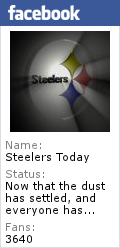The offense and the Steelers’ draft (part 2)
April 14, 2009
By Donald Starver
This is part 2 in a series. If you haven’t read part 1, click here.
In Part 1 of this series, we talked about the offensive tackle position. In this installment, we will be looking at the guard position.
The guards are the two players who play on either side of the center. The guard on the center’s left is the left guard. The guard on the center’s right is the right guard (insert deodorant joke here).
Unlike the offensive tackle position, where the right tackle and left tackle have somewhat different jobs, the role of the right and left guards are essentially the same.
The guards have two primary responsibilities. When the offense is running a pass play, the guard’s job is to create an impenetrable wall against the charging defensive tackle or linebacker. The guard must be able to stand his ground despite the best efforts of the defense to get at the quarterback. Not only must the guard be strong, but he also has to be somewhat mobile to prevent defensive linemen from going around him, rather than through him.
When the team is running the ball, the guard’s job is to push back the defenders in order to create a hole for the running back to go through. While not always true, we often find that the best run blockers are a bit smaller and faster than the best pass blockers. This is particularly true for teams that run a lot of traps and sweeps. Chuck Noll’s Steelers were famous for running trap plays in which mobile guards often had to move in order to block a defender who was far from his starting position at the snap.
However, teams that utilize primarily a “power running game” will prefer bigger, stronger guards, rather than the smaller, quicker guards used in trapping offenses or West Coast offenses.
Guards may be valued less than any other offensive position. In many draft years, no guards are selected in the first round. This doesn’t seem to prevent teams from finding quality players. Unlike the left tackle position, quality starters at the guard position are often drafted in the 4th-7th rounds.
The Steelers can use an upgrade at both guard positions. Left guard Chris Kemoeatu is massive, but doesn’t tend to play with a mean streak. Moreover, he is prone to making mental errors.
Darnell Stapleton played admirably at the right guard position. He was unexpectedly called upon when Kendall Simmons went down with an injury, and he did better than most fans expected him to. However, he is not likely to be mistaken for Alan Faneca or Steve Hutchinson.
The class of 2009 is not a very strong class for guards. However, there are a few players worth noting.
Offensive guards:
Duke Robinson (6’5″, 335 lbs.), Oklahoma. A huge road grader who will excel in the running game. May lack the lateral mobility to handle elite interior linemen.
Herman Johnson (6’8″, 382 lbs.), LSU. A mammoth offensive lineman who will be bigger than just about anyone he plays against. He has big hands and good arm strength. However, his massive size does lead to some coordination issues. Some scouts have talked about moving him to tackle, but I don’t believe he has the lateral quickness for the position.
Kraig Urbik (6’5″, 323 lbs.), Wisconsin. Urbik is a versatile player who has played both tackle and guard in college. He is probably best suited to play guard at the next level, but scouts will take note of his ability to play multiple positions.
Andrew Levitre (6’2″, 306 lbs.), Oregon State. A left tackle in college, Levitre will switch to guard in the NFL. Has all the attributes needed to make the switch. Struggled at the Senior Bowl. Needs to get stronger.
Trevor Canfield (6’4″, 311 lbs.), Cincinnati. Had a great junior year, but failed to impress as a senior. It’s unclear which player will show up at the next level.
(If you enjoyed this article, please consider leaving a comment below. Also, please subscribe to our blog by pressing the orange button below. Thanks.)
http://steelerstoday.com/?p=512
// -->





